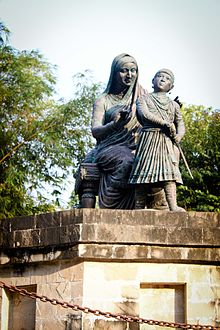Jijamata Udyaan
This article needs additional citations for verification. (September 2015) |
| Jijamata Udyaan | |
|---|---|
 Statue of Jijamata and Chhatrapati Shivaji Maharaj at Jijamata Udyaan | |
 | |
| 18°58′41″N 72°50′12″E / 18.9781154°N 72.8367457°E | |
| Date opened | 1861[1] |
| Location | Mumbai, India |
| Land area | 48 acres (19 ha)[1] |
| Memberships | CZA[2] |
Jijamata Udyaan (Template:Lang-mr) formerly called Ranichi Bagh (meaning Queen's Gardens) after the original British name Victoria Gardens, and now also known as Veermata Jijabai Bhosale Udyan, is a zoo and garden located at Byculla, in the heart of Mumbai, India. It was laid out in 1861 and is one of the oldest zoos in India.
Also, situated in the Gardens is the Dr. Bhau Daji Lad Museum (formerly Victoria and Albert Museum), mainly of industrial and agricultural interest. On the grounds to the east of the museum is the giant statue of an elephant, taken from the Elephanta Caves on Gharapuri to Britain in 1864, and later returned to these gardens.[3]
The Zoo
Jijamata Udyaan also houses the Mumbai Zoo. It houses many rare and endangered species of animals and birds and stuffed animals which are stuffed by many talented taxidermists. The state of the zoo degraded considerably and currently the zoo find its place in the list of worst zoos in the world by many independent institutions.[4][5] This has occurred owing mainly due to the poor hygienic conditions and indifference by the zoo staff.[4][5]
Dr. Bhau Daji Lad Museum
The Garden also houses Bhau Daji Lad Museum (formerly known as the Victoria and Albert Museum) which contains a large collection of archaeological artifacts. One example is a large stone elephant which is now kept at entrance of the garden. It was found in 1864 on Gharapuri Island. The museum's collection of Indian art and culture has been praised as one of the most valuable collections of Indian architecture. It was named after the Prince Consort and Queen Empress of India.[6]
-
Jijamata Udyaan Clocktower
-
Dr. Bhaudaji Lad Museum, Byculla
Notes
- ^ a b "Jijamata Udyan Zoo". clickindia.com. ClickIndia. Retrieved 4 July 2011.
- ^ "Search Establishment". cza.nic.in. CZA. Retrieved 4 July 2011.
- ^ "Save the Caves". the-south-asian.com. The South Asian. Retrieved 4 July 2011.
- ^ a b The world's worst zoos globalpost.com. Retrieved 24 August 2013
- ^ a b 6 of the saddest zoos in the world: Mumbai Zoo mnn.com. Retrieved 24 August 2013
- ^ "History of museum".








